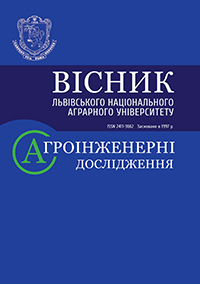RESEARCH OF MICROSTRUCTURE OF WIRES OF INTERNAL ELECTROMAGNETIC FUEL IN FIRE CONDITIONS
DOI:
https://doi.org/10.31734/agroengineering2018.01.129Keywords:
microstructure of conductors, electrical networks, local x-ray spectral analysis, oxygen content, short circuitAbstract
The article shows the current state and problems associated with the features of the construction of internal electrical networks, as well as problems associated with their fire danger. The official statistics presented are alarming and compel to seek ways and methods for an objective assessment of the reasons for the reasonableness of the internal electrical networks of these buildings before the occurrence of fires.
As shown in the paper, the methods used to detect the causes of fire today have significant disadvantages and therefore in many cases do not allow proper identification or confirmation of the primary causes of fire. In connection with this, the root causes of the fire are short circuit modes in the internal electricity grid, or violation of the rules of use of household electric heating devices, in particular the modes of their overloads.
In reality, these pointers are somewhat inflated, therefore, the task is to improve the technique of detecting the involvement of wires of internal electrical networks, or electrical equipment, which can lead to overloads or short circuits, until a fire is established. To this end, the authors carried out a large amount of experiments with copper and aluminum wires of electric current that would reproduce the real conditions, and the results of these experiments after their generalization allowed to improve the technique of fire and technical expertise.
Therefore, the issue of determining the root cause of the fire remains relevant. In order to maximally approximate the conditions of carrying out experimental research into real, different methods of heating were carried out: open fire (model fire), short circuit (current loads using a welding transformer), convective heating of hidden conductive conductors (muffle furnace). The article deals with changes in the microstructure of aluminum and copper conductors of internal electrical networks during the action of electric current (short circuit), open flame and heating in a muffle furnace. The properties and structure of aluminum and copper are considered. Copper is a crystalline material, that is, it is characterized by a three-dimensional periodicity in the arrangement of atoms. In this case, the specific location of atoms and the distance between them are different for different metals, the totality of atoms forms a crystal lattice. Experiments of different modes of heating conductors of electric networks have been carried out. On the basis of the local X-ray spectral analysis, the oxygen content dependences are formed and the differences in the microstructure of the conductors are shown, depending on the heating regime. The given results allow to determine the involvement of the electric current before the fire.
References
Hudym V. I., Nazarovets O. B. Analiz isnuiuchoi bazy metodiv doslidzhennia prychetnosti avariinykh rezhymiv elektromerezhi do vynyknennia pozhezhi. Tekhnohenna bezpeka: teoriia, praktyka, innovatsii: zb. tez II Mizhnar. nauk.-prakt. konf. Lviv: LDU BZhD, 2011. S. 67–69.
Hudym V., Karbonichek M., Nazarovets O. Analiz mikrostruktury midnykh kabelno-providnykovykh vyrobiv elektrychnykh merezh, yaki perebuvaly u seredovyshchi pozhezhi. Pozhezhna bezpeka. 2012. № 20. S. 144–149.
Hudym V. I., Mnukhin A. H., Nazarovets O. B., Yankiv V. V. Doslidzhennia prychetnosti elektrychnykh merezh do vynyknennia pozhezh na shakhtakh. Uhol Ukrayny. 2016. № 11–12. S. 29–32.
Hudym V. I., Nazarovets O. B., Kuzin O. A. Osoblyvosti mikrostruktury midnykh drotiv, nahritykh elektrychnym strumom i vidkrytym polumiam. Pozhezhna bezpeka. 2012. № 22. S. 55–60.
Ishakov H. I., Pahomov A. B., Kaminskiy Ya. N. Pozharnaya bezopasnost avtomobilya. Moskva: Transport, 1987. 86 s.
Lahtin Yu. M., Leonteva V. P. Materialovedenie: ucheb. dlya vyisshih tehn. ucheb. zavedeniy. 3-e izd., pererab. i dopoln. Moskva: Mashinostroenie, 1990. 528 s.
Maltsev M. V. Metallografiya promyishlennyih tsvetnyih metallov i splavov (s prilozheniem atlasa makro- i mikrostruktur). 2-e izd., pererab. i dopoln. Moskva: Metallurgiya, 1970. 343 s.
Ofitsiinyi sait Tsentru pozhezhnoi statystyky. URL: http://www.ctif.org/ctif/about-ctif.
Bulochnikov N. M., Zernov S. I., Stanovenko A. A., Chernichuk Yu. P. Pozhar v avtomobile: kak ustanovit prichinu? Moskva: Fligiston, 2006. 224 s.
Smelkov G. I. Pozharnaya bezopasnost elektroprovodok. Moskva: Kabel, 2009. 328 s.
Statystyka – DSNS Ukrainy. URL: http://www.undicz.dsns.gov.ua/ua/Statistica.html.
Babrauskas V. Mechanisms and Modes for Ignition of Low-voltage, PVC-insulated Electrotechnical Products. Fire & Materials. 2006. № 30. P. 150–174.
Béland B. Electricity…The Main Fire Cause? Fire and Arson Investigator. 1982. № 32. P. 18–22.
Xiaojun C., Lizhong Y., Zhihua D., Weicheng F. A multi-layer zone model for predicting fire behavior in a fire room. Fire Safety Journal. 2005. № 40. P. 267–281.
Fire Statistics. URL: http://www.usfa.fema.gov/statistics/.
Hall J. R., Bukowski R. W., Gomberg A. Analysis of Electrical Fire Investigations in Ten Cities (NBSIR 83-2803), [U.S.] Natl. Bur. Stand., Gaithersburg MD, 1983.
Lindsay T. National Electrical Grounding Research Project. Fire Protection Research Foundation, Quincy, MA, 2007.
Nazarovets O. B., Gudуm V. I., Kuzin O. A. Features of changing the structure of copper conductors in terms of the current complex and high temperature. Science and Education a New Dimension. Natural and Technical Sciences. 2015. III(6), іs. 54. Р. 47–51.
Rohr K. D., The U.S. Home Product Report (Appliances and Equipment Involved in Fires), Fire Analysis & Research Div., National Fire Protection Assn., Quincy MA, 2000.
Smith L., McCoskrie D. What Causes Wiring Fires in Residences. Fire Journal. 1990. 84, 1. Р. 19–24.


